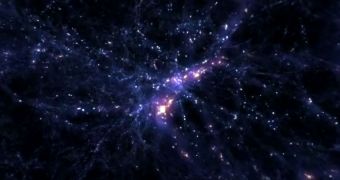Work on the James Webb Space Telescope, the successor of the renowned Hubble telescope, are progressing smoothly in the United States, but NASA experts wanted to know what sights the observatory will be able to see. A new series of simulations shows that.
When completed, in a couple of years, the telescope will be the most advanced ever created, boasting a range of revolutionary technologies that have never been tried out before.
JWST will be placed at the L2 orbital point, from which it will remain in the same relative position when compared to the Sun-Earth-Moon system. This will allow its detectors to be protected from any stray light that might hamper its long-distance observations.
It will be able to peer deeper into the Universe than ever before, and also to observe phenomena that have until now avoided direct studies. These include exoplanetary formation, the birth and death of stars, the rotations of accretion disks around black holes and so on.
But, for all the technology put into the JWST, experts working on it still had no idea as to what type of data the massive observatory will deliver. Observations with this level of detail have never been made before.
So NASA turned to a specialized facility to aid it in simulating possible images that the JWST could return during its mission. Experts at the Advanced Visualization Laboratory (AVL) were happy to help.
The AVL is led by director Donna Cox, and is located at the National Center for Supercomputing Applications (NCSA). This organization is housed by the University of Illinois in Urbana-Champaign.
“It’s an interesting problem. How do we communicate the great scientific promise of the James Webb Space Telescope when we’ve never seen what it can show us?” says Jonathan Gardner.
The expert, who is based at the NASA Goddard Space Flight Center in Greenbelt, Maryland, is the deputy senior project scientist for the telescope project.
“We take the actual data scientists have computed for their research and translate them into state-of-the-art cinematic experiences,” Cox explains of how the AVL created the new simulations.
“Theorists are the only scientists who have ventured where Webb plans to go, and they did it through complex computer models that use the best understanding of the underlying physics we have today,” she adds.
“Our challenge is to make these data visually understandable - and reveal their inherent beauty,” the AVL director adds, quoted by Space Fellowship.
“What AVL has done for the Webb project is truly amazing and inspiring. It really wets our appetites for the science we’ll be doing when the telescope begins work a few years from now,” Gardner concludes.

 14 DAY TRIAL //
14 DAY TRIAL //